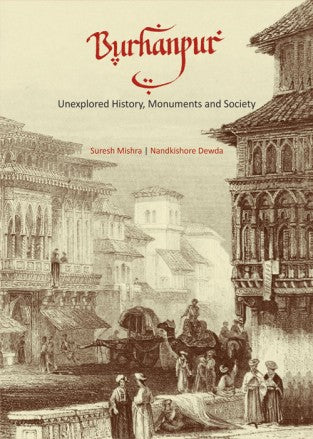BURHANPUR: Unexplored History, Monuments and Society
BURHANPUR: Unexplored History, Monuments and Society is backordered and will ship as soon as it is back in stock.
Couldn't load pickup availability
Genuine Products Guarantee
Genuine Products Guarantee
We guarantee 100% genuine products, and if proven otherwise, we will compensate you with 10 times the product's cost.
Delivery and Shipping
Delivery and Shipping
Products are generally ready for dispatch within 1 day and typically reach you in 3 to 5 days.
- Type: English
- Pages: x + 344
- Format: Hard Bound
- ISBN: 9788186787212
- Edition: 1st Edition
- Publisher: ABI
- Size: 22 cm x 31 cm
- Product Year: 2018
The present volume deals with the history, culture and social life of Burhanpur since its inception. Founded by Faruqi ruler Nasir Khan in 1407, the city was the capital of the Faruqi kingdom for two centuries, till its occupation by the Mughal emperor Akbar at the close of the 16th century. The Faruqi rulers were quite tolerant by the standards of those times and consequently Burhanpur gradually became a centre of the Sufi saints who came and settled here from all parts of the country. Raja Ali Khan, a Faruqi Sultan was so liberal that he inscribed Sanskrit inscriptions along with the Arabic inscriptions in the mosques of Burhanpur and nearby Asirgarh. After the fall of the Faruqis, the Mughals held their sway, and Burhanpur became the headquarters of the Suba of Khandesh becoming very important politically. During the Mughal rule, peace and prosperity prevailed, leading to an increase in trade and commerce and the city became an important centre for domestic and foreign trade. Gujarati and Rajasthani traders and Bohra community capitalized on this trade opportunities and settled here.
For the huge population of Burhanpur, a unique water supply system was built during the reign of the Mughal Emperor Jahangir on the lines of Qanat system of Iran, under the supervision of Abdur Rahim Khan-i-Khanan, who stayed at Burhanpur for many years as an administrator.
During the later Mughals, due to Maratha onslaughts, the trade and commerce of Burhanpur was affected adversely. The Nizam tried to give some stability by building a long rampart wall around the city to protect it from Maratha onslaughts, but ultimately he had to succumb to the growing Maratha power and Burhanpur was occupied by the Peshwa in 1750. Later Peshwa handed it over to the Scindia in 1778 who held it till 1860.
There has been a confluence of various religions in Burhanpur and people of various sects settled here, contributing to the growth of a composite culture. A couple of chapters in the volume are based on the memoirs of the older generation of the city, giving an intimate glimpse of the past.





